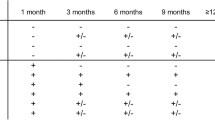Abstract
Residual hemifacial spasm (HFS) after microvascular decompression (MVD) is common, and the factors associated with residual HFS are still controversial. In the present study, we analyzed the outcome of 212 patients with hemifacial spasm after a single microvascular decompression and evaluated the prognostic factors involved in residual hemifacial spasm. Based on our study, possible prognostic factors included indentation of the root exit zone (REZ), preoperative illness duration, and preoperative psychological state. We suggest that MVD should be performed as early as possible for it may decrease the rate of residual HFS. Preoperative assessment of psychological state in HFS patients is a timely intervention that should be implemented to minimize the residual HFS.
Similar content being viewed by others
References
Au WL, Tan LC, Tan AK (2004) Hemifacial spasm in Singapore: clinical characteristics and patients ' perceptions. Ann Acad Med Singap 33(3):324–328
Broocks A, Thiel A, Angerstein D, Dressler D (1998) Higher prevalence of obsessive-compulsive symptoms in patients with blepharospasm than in patients with hemifacial spasm. Am J Psychiatry 155(4):555–557
Burbaud P, Arnaud A, Burbaud A, Laqueny A (1995) Clinical and psychological factors influencing the efficacy of botulinum toxin in the treatment of hemifacial spasm and blepharospasm. J Fr Ophtalmol 18(12):751–757
Chung SS, Chang JH, Choi JY, Chang JW, Park YG (2001) Microvascular decompression for hemifacial spasm: a long-term follow-up of 1,169 consecutive cases. Stereotact Funct Neurosurg 77(1–4):190–193
Goto Y, Matsushima T, Natori Y, Inamura T, Tobimatsu S (2002) Delayed effects of the microvascular decompression on hemifacial spasm: a retrospective study of 131 consecutive operated cases. Neurol Res 24(3):296–300
Hitotsumatsu T, Matsushima T, Inoue T (2003) Microvascular decompression for treatment of trigeminal neuralgia, hemifacial spasm, and glossopharyngeal neuralgia: three surgical approach variations: technical note. Neurosurgery 53(6):143614–41, discussion 42-43
Hyun SJ, Kong DS, Park K (2010) Microvascular decompression for treating hemifacial spasm: lessons learned from a prospective study of 1,174 operations. Neurosurg Rev 33(3):325–334, discussion 34
Ishikawa M, Nakanishi T, Takamiya Y, Namiki J (2001) Delayed resolution of residual hemifacial spasm after microvascular decompression operations. Neurosurgery 49(4):847–854, discussion 54-56
Jo KW, Kong DS, Park K (2013) Microvascular decompression for hemifacial spasm: long-term outcome and prognostic factors, with emphasis on delayed cure. Neurosurg Rev 36(2):297–301, discussion 301-302
Kim HR, Rhee DJ, Kong DS, Park K (2009) Prognostic factors of hemifacial spasm after microvascular decompression. J Kor Neurosurg Soc 45(6):336–340
Kong DS, Park K, Shin BG, Lee JA, Eum DO (2007) Prognostic value of the lateral spread response for intraoperative electromyography monitoring of the facial musculature during microvascular decompression for hemifacial spasm. J Neurosurg 106(3):384–387
Li CS (2005) Varied patterns of postoperative course of disappearance of hemifacial spasm after microvascular decompression. Acta Neurochir (Wien) 147(6):617–620, discussion 20
Moller AR (1999) Vascular compression of cranial nerves: II: pathophysiology. Neurol Res 21(5):439–443
Moller AR, Jannetta PJ (1984) On the origin of synkinesis in hemifacial spasm: results of intracranial recordings. J Neurosurg 61(3):569–576
Moller AR, Jannetta PJ (1985) Microvascular decompression in hemifacial spasm: intraoperative electrophysiological observations. Neurosurgery 16(5):612–618
Nielsen VK (1985) Electrophysiology of the facial nerve in hemifacial spasm: ectopic/ephaptic excitation. Muscle Nerve 8(7):545–555
Rosenstengel C, Matthes M, Baldauf J, Fleck S, Schroeder H (2012) Hemifacial spasm: conservative and surgical treatment options. Dtsch Arztebl Int 109(41):667–673
Saito S, Moller AR, Jannetta PJ, Jho PD (1993) Abnormal response from the sternocleidomastoid muscle in patients with spasmodic torticollis: observations during microvascular decompression operations. Acta Neurochir (Wien) 124(2–4):92–98
Samii M, Gunther T, Laconetta G, Muehling M, Vorkapic P, Samii A (2002) Microvascular decompression to treat hemifacial spasm: long-term results for a consecutive series of 143 patients. Neurosurgery 50(4):712–718, discussion 8-9
Sanders DB (1989) Ephaptic transmission in hemifacial spasm: a single-fiber EMG study. Muscle Nerve 12(8):690–694
Scheidt CE, Schuller B, Rayki O, Kommerell G, Deuschl G (1996) Relative absence of psychopathology in benign essential blepharospasm and hemifacial spasm. Neurology 47(1):43–45
Shin JC, Chung UH, Kim YC, Park CI (1997) Prospective study of microvascular decompression in hemifacial spasm. Neurosurgery 40(4):730–734, discussion 4-5
Sindou M, Keravel Y (2009) Neurosurgical treatment of primary hemifacial spasm with microvascular decompression. Neurochirurgie 55(2):236–247
Tan EK, Fook-Chong S, Lum SY (2006) Case-control study of anxiety symptoms in hemifacial spasm. Mov Disord 21(12):2145–2149
Tan EK, Lum SY, Fook-Chong S, Chan LL, Gabriel C, Lim L (2005) Behind the facial twitch: depressive symptoms in hemifacial spasm. Parkinsonism Relat Disord 11(4):241–245
Conflicts of interest
The authors declare that they have no financial or other conflicts of interest in relation to this research and its publication.
Author information
Authors and Affiliations
Corresponding author
Additional information
Comments
Andrei Koerbel, Joinville, Brasil
The manuscript entitled “Residual hemifacial spasm after microvascular decompression: prognostic factors with emphasis on preoperative psychological state” aims to identify prognostic factors for residual symptoms after surgical treatment for hemifacial spasm.
The topic is noteworthy since the literature lacks suitable information about psychological evaluation in patients suffering from this disorder. The results and limitations of the study were properly described by the authors.
The authors’ findings match my personal experience. Anxious patients tend to have a higher probability to persist with residual spasms after surgical treatment. In these cases, postoperative treatment with medication for anxiety may lead to relieve these residual symptoms.
Rights and permissions
About this article
Cite this article
Jin, Y., Zhao, C., Su, S. et al. Residual hemifacial spasm after microvascular decompression: prognostic factors with emphasis on preoperative psychological state. Neurosurg Rev 38, 567–572 (2015). https://doi.org/10.1007/s10143-015-0622-6
Received:
Revised:
Accepted:
Published:
Issue Date:
DOI: https://doi.org/10.1007/s10143-015-0622-6




